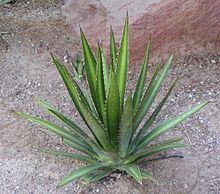Agave lechuguilla
| Agave lechuguilla | |
|---|---|

| |
| Scientific classification | |
| Kingdom: | Plantae |
| Clade: | Tracheophytes |
| Clade: | Angiosperms |
| Clade: | Monocots |
| Order: | Asparagales |
| Family: | Asparagaceae |
| Subfamily: | Agavoideae |
| Genus: | Agave |
| Species: | A. lechuguilla
|
| Binomial name | |
| Agave lechuguilla | |
| Synonyms[2] | |
| |
Agave lechuguilla (common name in Chihuahua: lechuguilla, meaning "little lettuce") is an agave species found only in the Chihuahuan Desert, where it is an indicator species.[3] It typically grows on calcareous soils.[4] The plant flowers once in its life, then it dies. The flowers are a source of nutrients for insects, bats, and some birds.
The leaves are long, tough and rigid, with very sharp, hard points which can easily penetrate clothing and even leather, giving the colloquial name "shin-daggers". Native Americans have used fibers from the leaves (commonly called ixtle'."
The water stored in the flowering stalks of this plant, rich in salts and minerals, is sold in Mexico as a sport drink. The plant makes up a large part of the diet of the collared peccary (javelina) in some areas.[5] It is toxic to cattle and sheep, however.[6]
References
- ^ "Taxon: Agave lechuguilla Torr". Germplasm Resources Information Network. United States Department of Agriculture. 2009-02-24. Retrieved 2011-05-02.
- ^ Kew World Checklist
- ^ West, Steve (2000). Northern Chihuahuan Desert Wildflowers. Globe Pequot. p. 44. ISBN 978-1-56044-980-5.
- ^ Turner, Matt (2009). Remarkable Plants of Texas: Uncommon Accounts of Our Common Natives. Austin: University of Texas Press. pp. 109–113. ISBN 978-0-292-71851-7.
- ^ Corn, J. L. and R. J. Warren. (1985). Seasonal food habits of the collared peccary in South Texas. Journal of Mammalogy. 66:1 155-59.
- ^ Lechuguilla. Toxic plants of Texas. Texas A&M.
External links
 Data related to Agave lechuguilla at Wikispecies
Data related to Agave lechuguilla at Wikispecies Media related to Agave lechuguilla at Wikimedia Commons
Media related to Agave lechuguilla at Wikimedia Commons- USDA Plants Profile for Agave lechuguilla (lechuguilla)
- University of Michigan - Dearborn: Native American Ethnobotany: Agave lecheguilla (Maguey lechuguilla)
- Thacker, H. 2013. Agave lechuguilla. The IUCN Red List of Threatened Species. Version 2014.3. Downloaded on 11 April 2015.

